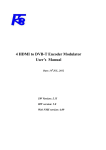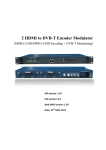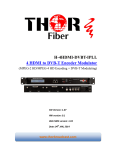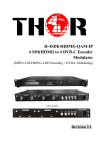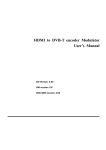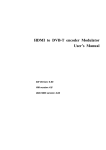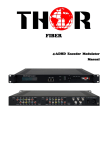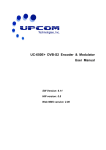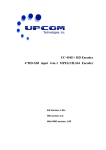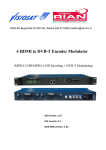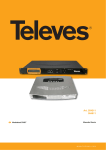Download HTT-100 Encoder Modulator User Manual
Transcript
HTT 100 1 HDMI to DVB-T Encoder Modulator (MPEG-2 HD/MPEG-4 HD Encoding + DVB-T Modulating) TABLE OF CONTENTS 1. SPECIFICATIONS.................................................................................................................................. 1 1.1 PRODUCT OVERVIEW.................................................................................................................................... 1 1.2 KEY FEATURES ............................................................................................................................................. 1 1.3 SPECIFICATIONS ........................................................................................................................................... 2 1.4 SYSTEM DIAGRAM ....................................................................................................................................... 3 1.5 APPEARANCE AND DESCRIPTION ..................................................................................................................... 3 2. INSTALLATION GUIDE ......................................................................................................................... 5 2.1 GENERAL PRECAUTIONS ................................................................................................................................ 5 2.2 POWER PRECAUTIONS ................................................................................................................................... 5 2.3 DEVICE’S INSTALLATION FLOW CHART ILLUSTRATED AS FOLLOWING ........................................................................ 5 2.4 ENVIRONMENT REQUIREMENT ....................................................................................................................... 5 2.5 GROUNDING REQUIREMENT .......................................................................................................................... 6 3. OPERATION ........................................................................................................................................ 7 3.1 LCD MENUS ............................................................................................................................................... 7 3.2 INITIAL STATUS ............................................................................................................................................ 8 3.3 GENERAL SETTINGS FOR MAIN MENU ............................................................................................................. 9 4. WEB NMS OPERATION ..................................................................................................................... 15 4.1 LOGIN ...................................................................................................................................................... 15 4.2 OPERATION .............................................................................................................................................. 16 5. SAFETY INSTRUCTIONS ..................................................................................................................... 24 6. PACKING LIST.................................................................................................................................... 24 1. SPECIFICATIONS 1.1 Product Overview The HTT-100 is a MPEG-2 HD/MPEG-4 HD (H.264) encoder with DVB-T modulation. It adopts inner drawer-type structural design which greatly facilitates the change of encoding modules (HDMI/CVBS/SDI/YPbPr/…) as needed. To meet customers’ various requirements, is also equipped with and 1 UDP IP port. The signals source could be from satellite receivers, closed-circuit television cameras, Blue-ray players, and antenna etc. Its output signals are to be received by TVs, STB and etc. with corresponding standard. This product is widely used in public places such as metro, market hall, theatre, hotels, resorts, and etc for advertising, monitoring, training and educating in company, schools, campuses, hospital… It’s a good choice to offer HD channels and more. 1.2 Key Features Up to 1920*1080@50I/60I supported (MPEG2 HD) ; Up to 1920*1080@50P/60P supported (MPEG4 HD)/ (H.264) MPEG-2 HD/MPEG-4 HD (H.264) video encoding MPEG1 Layer II (MPEG2-AAC, MPEG4-AAC available ) audio encoding 1* HDMI in (1 port for backup) Single RF DVB-T out 30MHz~960MHz Excellent modulation quality MER≥42dB LCD display, Remote control and firmware Updates via web 1 1.3 Characteristics Encoding Section Video Encoding MPEG2 HD/MPEG4 HD Input HDMI*1 (1 port for backup) Resolution 1920*1080_60P, 1920*1080_50P, (-for MPEG4/H.264) 1920*1080_60i, 1920*1080_50i, 1280*720_60p, 1280*720_50P 720*480_60i, 720*576_50i Audio encoding MPEG1 Layer II, (MPEG2-AAC, MPEG4-AAC available ) Sample rate 48KHz Bit rate 64kbps, 96kbps,128kbps, 192kbps, 256kbps, 320kbps DVB-T Modulator Section RF out RF COFDM DVB-T out (EN300744) FFT mode 2K, 8K Bandwidth 6M, 7M, 8M Constellation QPSK, 16QAM, 64QAM Guard Interval 1/4, 1/8, 1/16, 1/32 FEC 1/2, 2/3, 3/4, 5/6, 7/8 MER ≥42dB RF frequency 30~960MHz, 1KHz step RF output level -30~ -10dBm (75~97 dBµV), 0.1dB step System Local interface LCD + control buttons Remote management Web NMS output IP out (RJ45, 100M) NMS interface RJ45, 100M Language English General Power supply AC 100V~240V Dimensions 267*250*44mm Weight 2.5 kgs Operation temperature 0~45℃ 1.4 System Diagram 1.5 Appearance and Description Front Panel Illustration 1. 2. 3. 4. NMS Port Data Port (for IP output) RF Input Interface (for combiner) RF Output Interface Rear Panel Illustration 3 1. 2. 3. 4. 5. HDMI Input Interface group (1port for backup) Power Switch Fuse Power supply Slot Grounding Up Panel Illustration ① LCD window ② Power , Alarm and TS Lock Indicators ③ Up and Down, Left and Right Button ④ Enter Button: for confirm ⑤ Menu Button: for back step ⑥ Lock Button: press to lock set 2. Installation Guide This section is to explain the cautions the users must know in some cases that possible injure may bring to users when it’s used or installed. For this reason, please read all details here and make in mind before installing or using the product. 2.1 General Precautions Must be operated and maintained free of dust or dirty. The cover should be securely fastened, do not open the cover of the products when the power is on. After use, securely stow away all loose cables, external antenna, and others. 2.2 Power precautions When you connect the power source, make sure if it may cause overload. Avoid operating on a wet floor in the open. Make sure the extension cable is in good condition Make sure the power switch is off before you start to install the device 2.3 Device’s Installation Flow Chart Illustrated as following 2.4 Environment Requirement Item Requirement Machine Hall Space When user installs machine frame array in one machine hall, 5 the distance between 2 rows of machine frames should be 1.2~1.5m and the distance against wall should be no less than 0.8m. Electric Isolation, Dust Free Volume Machine Hall Floor resistivity of ground anti-static material: 1X107~1X1010Ω,Grounding current limiting resistance: 1MΩ (Floor bearing should be greater than 450Kg/㎡) Environment Temperature 5~40℃(sustainable ),0~45℃(short time), installing air-conditioning is recommended Relative Humidity 20%~80% sustainable 10%~90% short time Pressure 86~105KPa Door & Window Installing rubber strip for sealing door-gaps and dual level glasses for window Wall It can be covered with wallpaper, or brightness less paint. Fire Protection Fire alarm system and extinguisher Power Requiring device power, air-conditioning power and lighting power are independent to each other. Device power requires AC 110V±10%, 50/60Hz or AC 220V±10%, 50/60Hz. Please carefully check before running. 2.5 Grounding Requirement All function modules’ good grounding is the basis of reliability and stability of devices. Also, they are the most important guarantee of lightning arresting and interference rejection. Therefore, the system must follow this rule. Grounding conductor must adopt copper conductor in order to reduce high frequency impedance, and the grounding wire must be as thick and short as possible. Users should make sure the 2 ends of grounding wire well electric conducted and be antirust. It is prohibited to use any other device as part of grounding electric circuit The area of the conduction between grounding wire and device’s frame should be no less than 25 mm2. 3. Operation 3.1 LCD Menus An overview of the LCD menus: 7 3.2 Initial Status Switch on the device and after a few seconds’ initialization, it presents start-up pictures as below: Start up… Start OK… DVB-T X.XXMbps XXX.00MHz X.XXMbps DVB-T: indicate the modulation standard of this device XXX.XX MHz indicates the current output frequency ( range: 30~960MHz) X.XX Mbps indicate the encoding bit rate. 3.3 General Settings for Main Menu Press “Lock” key on the front panel to enter the main menu. The LCD will display the following pages where user can configure the parameters for the device: 1 Alarm Status 2 Encode Setting 3 Modulate Setting 4 IP Output Setting 5 Network Setting 6 Saving Config 7 Loading Config 8 Version User can press UP/DOWN buttons to specify menu item, and then press ENTER to enter the submenus as below: 1) Alarm Status The alarm indicator will turn on if there is no A/V signals inputting or outputting bit rate overflows. User then can enter this menu to check the error type. 2) Encode Setting Under this submenu, the LCD will show “2.1 Input 1”, “2.2 Input 2” and “2.3 ASI”. 2.1 Input 1 2.2 Input 2 Under submenus 2.1, user could set the video encoding format and bit rate, and set audio encoding bit rate and also read the audio encoding format of the program from the HDMI input. 2.1 Input 1 9 MPEG2 Video Format Video Bit Rate Audio Format Audio Bit Rate H.264 Video Bit Rate 08.000 Mbps MPEG2 MPEG4 AAC 64 Kbps 96 Kbps “Video Format”: the HDMI MPEG2 HD encoding module supports both MPEG2 and H.264 formats. Move the triangle mark with LEFT/RIGHT keys to specify the intended format and press ENTER to confirm. “Video Bit Rate”: Move the underline with LEFT/RIGHT keys and modify the value of frequency with UP/DOWN keys, and press ENTER key to save the settings. “Audio Format”: the encoding module supports MPEG2 and MEPG4 AC audio formats. Move the triangle mark with UP/DOWN keys to specify the intended format and press ENTER to confirm NOTE: Submenu “2.2 Input 2” is not applicable to the HTT 100 encoder modulator. It is equipped with only one input slot, while the LCD menu program is written to be compatible to the 1U model with 2 encoding slots. 3) Modulator Setting When entering “Modulator Setting” submenu, user can find below different parameters can be set and the LCD window would show as below: 3.1 Bandwidth 3.2 Constellations 3.3 Transmission Mode 3.4 Guard Interval 3.5 Code Rate 3.6 RF Frequency 3.7 RF Out Level Bandwidth There are three possible options provided for selecting bandwidth: 6M, 7M, and 8M. When the display shows them, user just need swift LEFT and RIGHT key to choose and repressing ENTER to confirm. Bandwidth 8M 7M 6M Constellation There are three different constellations QPSK, 16QAM and 64QAM shown on the LCD window. When entering Constellation, user can apply the same setting method as mentioned above to select and confirm one mode. Constellation QPSK 16QAM 64QAM Transmission Mode When user enters Transmission Mode, the LCD would show the current working mode. User can move LEFT/RIGHT keys to select and press ENTER key to confirm. 2K and 8K are the options: Transmission Mode 2K 8K 2K: When the device works as current mode, the number of current carrier is 2048 8K: When the device works as current mode, the number of current carrier is 8192 Guard Interval In communications, guard intervals are used to ensure that distant transmissions do not interfere with each other. These transmissions may belong to different users (as in TDMA) or same user (as in OFDM). The purpose of the guard interval is to introduce immunity to propagation delays, echoes and reflections, to which digital 11 data is normally very sensitive. There are four possible options provided to be selected. They are 1/4, 1/8, 1/16, 1/32. User can shift the LEFT/RIGHT keys to select and press ENTER to confirm. Guard Interval 1/32 1/16 1/8 1/4 Code Rate The code rate includes 1/2, 2/3, 3/4, 5/6, and 7/8. After entering this submenu, the LCD display would show them, users just need press LEFT and RIGHT buttons to choose and press ENTER button to confirm. Code Rate 1/2 2/3 3/4 5/6 7/8 RF Frequency The RF output frequency range is from 30 to 960MHz with 1K stepping. After entering the RF frequency setting submenu, users the can press LEFT, RIGHT, UP, and DOWN buttons to adjust the channel center frequency and confirm by press ENTER button. RF Frequency 750.000 MHz RF Out Level The RF attenuation range is -30~-10dBm (75~97dBµV) with 0.1dB step. After entering this setting submenu, user can shift UP/DOWN/LEFT/RIGHT key to set the output level and press ENTER to confirm. RF Out Level -10.0 dbm 4) IP Output Setting 4.1 IP Output 4.2 Service IP 4.3 Output IP 4.4 Subnet Mask 4.5 Gateway 4.6 Port User can enter 4.1. to decide whether to turn the IP port on or off, and enter to the rest menu items to set the corresponding parameters. 5) Network setting After enter Network Setting, there are three submenus shows as the following LCD displays. 5.1 IP Address 5.2 Subnet Mask 5.3 Gateway 5.4 MAC Address 5.5 Reset Password 5.6 Web Manage Port User can press “UP/DOWN” to choose this item and “ENTER” & “LEFT/RIGHT” to set the parameters. IP Address 192.168.000.136 Subnet Mask 255.255.255.000 Gateway 192.168.000.001 MAC Address ffffffffffffffffffffff Reset Password? Yes NO Web Manage Port 00080 NOTE: The MAC address is according to the factory setting, and it is unique. 13 6) Saving Configuration Users can enter Saving Configuration submenu for saving settings. Choose yes and press ENTER to confirm. Save Configuration? Yes No 7) Saving Config… Loading Configuration At this menu, user can press UP/DOWN key to select and repress ENTER to confirm. User can restore the device into the last saved configuration by choosing “7.1” and restore the device into factory configuration by choosing “7.2” the display will show as below: 7.1 Load Saved CFG 7.2 Load Default Load Saved CFG? Yes No 8) Loading Config… Version User can check the software version and hardware version of this equipment under this submenu. Encoder Modulator SW 6.07 HW 5.3 4. WEB NMS Operation User not only can use front buttons to set configuration, but also can control and set the configuration in computer by connecting the device to web NMS Port. User should ensure that the computer’s IP address is different from the device’s IP address; otherwise, it would cause IP conflict. 4.1 login The default IP address of this device is 192.168.0.136. (We can modify the IP through the front panel.) Connect the PC (Personal Computer) and the device with net cable, and use ping command to confirm they are on the same network segment. If the PC IP address is 192.168.99.252, we then change the device IP to 192.168.99.xxx (xxx can be 0 to 255 except 252 to avoid IP conflict). Use web browser to connect the device with PC by inputting the Encoder & Modulator’s IP address in the browser’s address bar and press Enter. It will display the Login interface as Figure-1. Input the Username and Password (Both the default Username and Password are “admin”.) and then click “LOGIN” to start the device setting. Figure-1 15 4.2 Operation When we confirm the login, it displays the WELCOME interface as Figure-2. It automatically identifies and displays the signal source interface and real-time encoding bit rate of corresponding input channel. User can click any item here to enter the corresponding interface to check information or set the parameters. TS indicators—Green light indicates the TS is normal, which otherwise turns to red. Figure-2 Input 1 From the menu on left side of the webpage, clicking “Input 1”, it displays the information of the program from the 1st HDMI encoding module as Figure-3. General Settings for the HDMI IN program: User can edit any item listed as needed. Encoding Status—Green light indicate it works normally, which otherwise turn to red. Figure-3 For user to turn to refer detailed explanation of terms on this interface Click this button to apply the default setting of Input 1 Click this button to apply the modified parameters. NIT Table setting Click “NIT” from the menu to trigger the screen as Figure-4. Then click “Add” from this screen to add the program descriptor in NIT Table. 17 Figure-4 Click “Add” from this page, it will display the screen as Figure-5 where it requires to add Service ID and configure other parameters for the programs. Figure-5 Here by clicking “Add”, users can set the program LCN in its respective field. After setting all the data, users need to click on “Save” to save the setting. As Figure-6, click “Update NIT” to update the NIT information. Figure-6 IP Output Click “IP Output” from the left menu, it will display the screen as Figure-7 where to set the multicast IP Output address for the device if needed and set the IP output for the programs. After setting the parameters, click “Apply” to save the setting. Figure-7 Modulator Setting Enter in “Modulator” and it will display the Modulator Configuration screen as Figure-8 where can set modulation parameters. Bandwidth –Bandwidth selecting. (The default bandwidth is 8M) Constellation –QAM type selecting. (The default constellation is 64QAM) Transmission Mode –2K, 8K optional Guard Interval/Code Rate/RF Frequency/RF Out level – the default configuration is 19 as shown on Figure 8. After setting all the parameters, click “Apply” to save the Modulator Configuration. Figure-8 Save/Restore Clicking “Save/Restore” from the menu, it will display the screen as Figure-9 where can save the configuration permanently to the device. Click “Save Configuration”, for store the data permanently to the device. By using “Restore Configuration” user can restore the latest saved configuration to the device. By using “Factory Set” user can import the default factory configuration. Figure-9 Restart the Device Click “Reboot” from the menu, the screen will display as Figure-10. Here when clicking “Reboot” box, it will restart the device automatically. Figure-10 Update the Device Click “Firmware” from the menu it will display the screen as Figure-11. Here user can update the device by using the update file. Click “Browse” to find the path of the device update file for this device then click “Update” to update the device. 21 After updating the device, user needs to restart the device by using Reboot option. Figure-11 Network When user clicks “Network”, it will display the screen as Figure-12. It displays the network information of the device. Here user can change the device network configuration as needed. Figure-12 Change Password When user clicks “Password”, it will display the password screen as Figure-13. Here user can change the Username and Password for login to the device. After putting the current and new Username and Password, click Apply” to save the configuration. Figure-13 Keyboard and LCD Lock: If it is marked with “√”,the LCD and keyboard will be locked to avoid unrelated users’ modifying or view the device information and configurations. User can’t operate the keyboard & LCD while only the device IP address can be noted in the LCD window. IP Address 192.168.000.136 Backup/Load Click “Backup/Load” from the menu, it will display the screen as Figure-14. Backup Configuration – To back up the device configuration file to a folder Load Configuration – If user needs to load the old configuration to the device, click “Browse” and find the backup configuration file path. After selecting the file, click “Load File” to load the backup file to the device. 23 Figure-14 5. Safety Instructions Prevention Measure • • • • • • • Install the device in a place in which environment temperature is between 0 to 45 °C Make sure there is good ventilation around the equipment. Check the input AC is within the power supply working range and the connection is correct before switching on device Check the RF output level varies within tolerant range if it is necessary Check all signal cables have been properly connected Frequently switching on/off device is prohibited; the interval between every switching on/off must greater than 10 seconds. Protect against any liquid drops on the device. 6. Packing List HDMI Encoder Modulator User's Manual HDMI Cables Power Cord 1PC 1PC 1PC 1PC DECLARACION DE CONFORMIDAD DECLARATION DE CONFORMITÉ DECLARATION OF CONFORMITY DECLARAÇÄO DE CONFORMIDADE Fabricante/ Fabricant/ Manufacturer/ Fabricante : FAGOR ELECTRONICA, S.COOP. Dirección/ Adresse/ Address/ Direçao : Bº San Andrés s/n - P.O. Box 33 20500 MONDRAGON (Guipúzcoa) Spain NIF / VAT : F-20 027975 Declara bajo su exclusiva responsabilidad la conformidad del producto : Declare, sous notre responsabilité, la conformité du produit : Declare under our own responsibility the conformity of the product : Declara exclusiva responsabilidade a conformidade do producto : HTT 100 Según los requerimientos de las Directivas del Parlamento Europeo: Selon les especifications des Directives du Parlament Européen : According to the specifications of directives of the European Parliament: Com as especificaçöes da Directivas do Parlamento Europeu: EMC LVD RoHS 2004/108/EC 2006/95/EC 2011/65/EC Para su evaluación se han aplicado las Normas: Pour l’évaluation ont étais appliqués les Normes: For the evaluation, the following Standards were applied: Para a avaliaçäo, os seguintes Normas foram aplicados : EN 50083-2 : 2012 EN 55013 :2001 + A1 : 2003 + A2 : 2006 EN 55020 :2007 EN 61000-3-2 : 2006 + A1 :2009 EN 61000-3-2 : 2008 Fecha: Firma: May 2013 Date: J.M. Saiz Signature: Jefe Calidad Tratamiento de Señal Head of Quality Dept., Signal Processing 25 Fagor Electrónica, S.Coop. San Andrés, s/n. P. O. Box 33 E-20500 Mondragón (Spain) Tel. +34 943 712 526 Fax +34 943 712 893 E-mail: [email protected] www.fagorelectronica.com




























